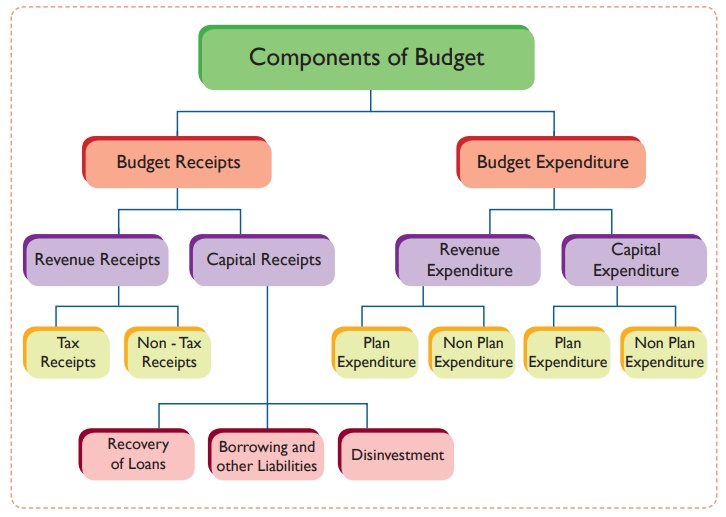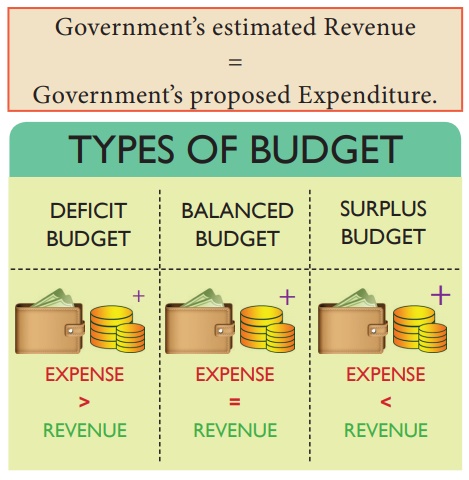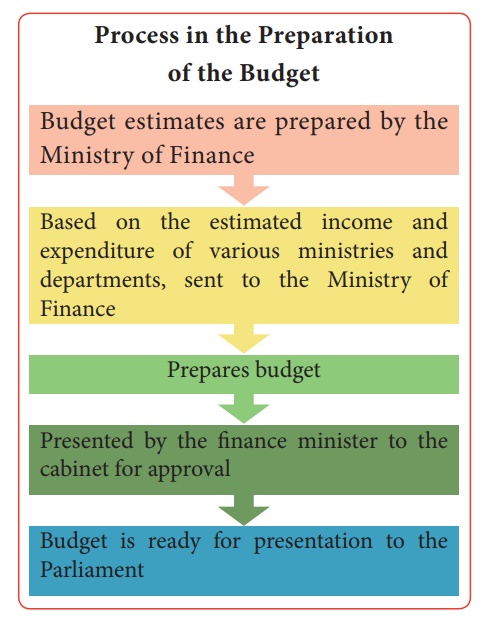Definitions, Types, Budgetary Procedure, Budgetary Deficits - Economics - Budget | 12th Economics : Chapter 9 : Fiscal Economics
Chapter: 12th Economics : Chapter 9 : Fiscal Economics
Budget
Budget
The word ‘budget’ is said to have its origin from the French word
“Bougett” which refers to ‘a small leather bag’. The budget is an annual
financial statement which shows the estimated income and expenditure of the
Government for the forthcoming financial year.
1. Definitions
“It is a document containing a preliminary approved plan of public
revenue and expenditure”.-Reney Stourn.
“The budget has come to mean the financial arrangements of a given
period, with the usual implication that they have been submitted to the
legislature for approval”.- Bastabale
2. Union Budget and State Budget
India is a federal economy, hence public budget is divided into
two layers of the Government. According to the Indian Constitution, the Central
Government has to submit annual financial statement, i.e., Union Budget under
Article 112 to the Parliament and each State Government has to submit the same
for the State in the Legislative Assembly under Article 202.
3. Types of Budget
Revenue and Capital Budget
On the basis of expenditure on revenue account and other accounts,
a budget can be presented in two ways:
i) Revenue Budget: It consists of revenue receipts and
revenue expenditure. Moreover, the revenue receipts can be categorised into tax
revenue and non-tax revenue. Revenue expenditure can also be categorised into
plan revenue expenditure and non-plan revenue expenditure.
ii) Capital Budget: It consists of capital receipts and
capital expenditure. In this case, the main sources of capital receipts are
loans, advances etc. On the other side capital expenditure can be categorised
into plan capital expenditure and non-plan capital expenditure.
iii) Supplementary Budget: During the time of war emergencies and
natural calamities like tsunami, flood etc, the expenditures allotted in the
budget provisions are not always enough. Under these circumstances, a
supplementary budget can be presented by the Government to tackle these
unforeseen events.
iv) Vote - on - Account: Under Article 116 of the Indian
Constitution, the budget can be presented in the middle of the year. The reason
may be political in nature. The existing Government may or may not continue for
the year, on account of the fact that elections are due, then the Government places
a ‘lame duck budget’. This is also called ‘Vote-on-account Budget’.

The vote on account budget is a special provision by which the
Government gets permission from the parliament to incur expenditures on
necessary items till the budget is finally passed in the parliament. The legal
permission of both the Houses of the parliament for the withdrawal of money
from the Consolidated Fund of India to meet the requisite expenses till the
budget is finally approved is known as vote-on - account budget. This type of
budget is generally sanctioned for not more than two months.
v) Zero Base Budget: The Government of India presented
Zero-Base-Budgeting (ZBB first) in 1987-88. It involves fresh evaluation of
expenditure in the Government budget, assuming it as a new item. The review has
been made to provide whole in the light of the socio-economic objectives
which have been already set up for this project and as well as in view of the
priorities of the society.
vi) Performance Budget: When the outcome of any activity is taken
as the base of any budget, such budget is known as ‘Performance Budget’. For
the first time in the world, the performance budget was made in USA. The
Administrative Reforms Commission was set up in 1949 in America under Sir Hooper.
This commission recommended making of a ‘Performance Budget’ in USA. In
the Performance Budget, it is the compulsion of the government to tell ‘what is
done’, ‘how much done’ for the betterment of the people. In India, the
Performance Budget is also known as ‘Outcome Budget’.
vii) Balanced Budget Vs Unbalanced Budget
A. Balanced Budget
Balanced budget is a situation, in which estimated revenue of the
government during the year is equal to its anticipated expenditure.

B. Unbalanced Budget
The budget in which Revenue & Expenditure are not equal to
each other is known as Unbalanced Budget.
Unbalanced budget is of two types:
1. Surplus Budget
2. Deficit Budget
1. Surplus Budget
The budget is a surplus budget when the estimated revenues of the
year are greater than anticipated expenditures.
Government Estimated revenue > Estimated Government
Expenditure.
2. Deficit Budget
Deficit budget is one where the estimated government expenditure
is more than expected revenue.
Government’s estimated Revenue < Government’s proposed
Expenditure.
4. Budgetary Procedure
Budgetary procedure refers to the system through which the budget
is prepared, enacted and executed.
(A) Preparation of the Budget
The Ministry of Finance prepares the Central Budget every year. At
the state level the finance department is responsible for the Annual State
Budget. While preparing the budget, the following factors are taken into
account:
·
The macro economic targets to be achieved within a plan period;
·
The basic strategy of the budget;
·
The financial requirements of different projects;
·
Estimates of the revenue expenditures (includes defence
expenditure, subsidy, interest payment on debt etc.);
·
Estimates of the capital expenditures (includes development of
railways, roadways, irrigations etc.);
·
Estimates of revenue receipts from tax and non-tax revenues;
·
Estimates of capital receipts from the recovery of loans,
disinvestment of public sector units, market borrowings etc.
·
Estimates of the gap between revenue receipts and revenue
expenditure; and
·
Estimates of fiscal deficit, primary deficit, and revenue deficit.

(B) Presentation of the Budget
The hon’ble Minister of Finance, on behalf of the Central
Government, places the Union Budget before Parliament on the eve of a new
financial year. Similarly at state levels, the Hon’ble Finance Minister of the
respective State Government places the State Budget before the State
Legislature.
According to the Indian Constitution, all money bills must be
initiated in the Lower House. All the money bills are first placed before the
LokSabha at the Centre, and before the VidhanSabha at the State level. The
demands of various tax proposals are included in the budget. After the finance
bill is passed, an appropriation bill is presented to give legal effect to the
voted demands, and to authorise the expenditure as per the budget. In this way,
the budgets are enacted in India.
(c) Execution of the Budget
The budget is mainly executed by different departments of the
Government. Proper execution of the budgetary provisions are important for the
efficient utilisation of the allocated funds.
Parliamentary Control over the Budget
In India, the Government Accounts are maintained in three parts:
(i) Consolidated Fund
(ii) Contingency Fund
(iii) Public Accounts
There are also two committees of parliament, viz,
(i) The Public Accounts Committee, and
(ii)The Estimates Committee.
These committees keep a constant vigil on the expenditure so that
no Ministry or Department exceeds the amount sanctioned to it.
5. Budgetary Deficits
Budget deficit is a situation where budget receipts are less than
budget expenditures. This situation is also known as government deficit.
In reference to the Indian Government budget, budget deficit is of
four major types.
(a) Revenue Deficit
(b) Budget Deficit
(c) Fiscal Deficit, and
(d) Primary Deficit
(A) Revenue Deficit
It refers to the excess of the government revenue expenditure over
revenue receipts. It does not consider capital receipts and capital expenditure.
Revenue deficit implies that the government is living beyond its means to
conduct day-to-day operations.
Revenue Deficit (RD) = Total Revenue Expenditure (RE) - Total
Revenue Receipts (RR),
When RE - RR > 0
(B) Budget Deficit
Budget deficit is the difference between total receipts and total
expenditure (both revenue and capital)
Budget Deficit = Total Expenditure – Total Revenue
(C) Fiscal Deficit
Fiscal deficit (FD) = Budget deficit + Government’s market
borrowings and liabilities
(D ) Primary Deficit
Primary deficit is equal to fiscal deficit minus interest
payments. It shows the real burden of the government and it does not include
the interest burden on loans taken in the past. Thus, primary deficit reflects
borrowing requirement of the government exclusive of interest payments.
Primary Deficit (PD) = Fiscal deficit (PD) - Interest Payment
(IP)
Related Topics